Turning Tamiya's 1/72
F-84 into a Thunderjet
MiG-Master | | The Inspiration It was an all-out effort for the 49th Fighter Bomber Wing the morning of September 19, 1951. Four dozen F-84E Thunderjets, each loaded with a pair of 500-pound bombs, winged toward a mail rail complex between Sinanju and Pyongyang in North Korea. One of the newest men in the unit was Captain Kenneth Skeen. A former F-80 driver, Skeen was in the number four position in Purple flight, the last flight of the last squadron, the 9th Fighter Bomber Squadron. 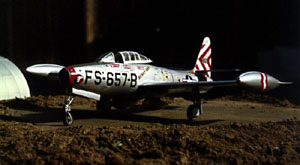 The radio silence was broken by the fighter controller. “MiG trains heading south,” the controller reported tersely. Skeen wasn't concerned; after a year of air combat, tactics had evolved to the point that it was taken for granted that F-86 Sabres would deal with them. What he didn't know was that the F-86s assigned to this mission were still on the ground at Kimpo. The 49th was on its own. The radio silence was broken by the fighter controller. “MiG trains heading south,” the controller reported tersely. Skeen wasn't concerned; after a year of air combat, tactics had evolved to the point that it was taken for granted that F-86 Sabres would deal with them. What he didn't know was that the F-86s assigned to this mission were still on the ground at Kimpo. The 49th was on its own.
As the group passed east of Pyongyang, the group leader calmly announced, “MiGs at one o'clock high.” The pilots craned their necks to spot the MiG-15s and to ascertain their intentions. If the MiGs were being challenged by the expected escort of F-86s, or if they were speeding south to challenge another strike, the rail-cutting mission could continue. If not, the F-84s would be forced to fight it out with the faster and harder-hitting MiGs. Suddenly, Skeen's radio came alive. “MiGs at three o'clock high!” “They're coming in! Salvo your bombs!” “Get up some speed!” “BREAK RIGHT, PURPLE FLIGHT!” 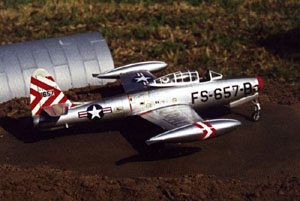 Skeen grabbed the bomb salvo handle and yanked hard, then threw the throttle to the stops while slamming the stick to the right. Being the last man in the flight, he was already struggling to maintain position; now, as the man at the far left of the formation, he was dropping even farther behind in the turn. The MiGs overshot their initial attack and pulled high to the left of Purple flight, then turned sharply to the right, hoping to pull in on the tail of the F-84s. At the same time, a desperate Skeen cut across the formation, hoping to join with element leader Major Jim Sprinkle on the far side of the flight. Skeen grabbed the bomb salvo handle and yanked hard, then threw the throttle to the stops while slamming the stick to the right. Being the last man in the flight, he was already struggling to maintain position; now, as the man at the far left of the formation, he was dropping even farther behind in the turn. The MiGs overshot their initial attack and pulled high to the left of Purple flight, then turned sharply to the right, hoping to pull in on the tail of the F-84s. At the same time, a desperate Skeen cut across the formation, hoping to join with element leader Major Jim Sprinkle on the far side of the flight.
Just then, a blue MiG-15 darted onto Sprinkle's tail—just ahead of Skeen. The MiG popped its airbrakes open and wiggled as the pilot tried to line his sights up on Sprinkle; Skeen, meanwhile, was traveling at full throttle. Skeen lined the MiG up, took his feet off the rudder pedals to make sure the F-84 was flying straight, and opened fire. 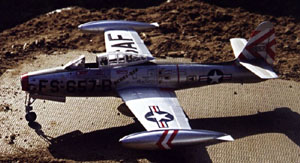 The four .50-caliber machine guns spattered the MiG with armor piercing incendiary rounds. Pieces of the MiG flew back in the slipstream, followed by several bursts of flame and a long trail of smoke. Skeen pulled to the left to avoid colliding with the MiG, which was now badly on fire. The MiG disappeared through a thin undercast, and as Skeen turned his head to the left to check for other threats he saw another blue MiG on the tail of an F-84. The four .50-caliber machine guns spattered the MiG with armor piercing incendiary rounds. Pieces of the MiG flew back in the slipstream, followed by several bursts of flame and a long trail of smoke. Skeen pulled to the left to avoid colliding with the MiG, which was now badly on fire. The MiG disappeared through a thin undercast, and as Skeen turned his head to the left to check for other threats he saw another blue MiG on the tail of an F-84.
“F-84! Break! Break... MiG on your tail! Break right!” shouted Skeen, hoping the F-84 would lead the MiG into his sights. When the F-84 broke, the wary MiG pulled up high to the left. As Skeen craned his neck to keep the MiG in sight, he broke through the low overcast, losing sight of the enemy. To his right, a single parachute floated by. Climbing out of the low cloud, Skeen found the sky empty. Where seconds before there had been more than 50 aircraft, now he was alone. With fuel low, he headed south for K-2, the first—and only—air-to-air combat victor for the 9th FBS in the Korean War. 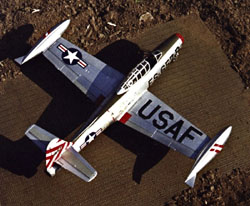 F-84s scored nine victories in Korea, and lost 18 planes in air-to-air fighting. Oddly, all of the victories came during 1951. However, the F-84 did amazing service as an air-to-ground weapon, flying 86,408 sorties and dropping 50,427 tons of bombs, 5,560 tons of napalm and 22,154 rockets on Communist emplacements. The F-84's most dramatic success came late in the war, when several units bombed huge dams in North Korea, precipitating floods that destroyed lines of communication and ruined valuable farmland. F-84s scored nine victories in Korea, and lost 18 planes in air-to-air fighting. Oddly, all of the victories came during 1951. However, the F-84 did amazing service as an air-to-ground weapon, flying 86,408 sorties and dropping 50,427 tons of bombs, 5,560 tons of napalm and 22,154 rockets on Communist emplacements. The F-84's most dramatic success came late in the war, when several units bombed huge dams in North Korea, precipitating floods that destroyed lines of communication and ruined valuable farmland.
The Conversion
I was looking forward to building the Tamiya kit of the F-84, as my
enthusiastic-to-the-point-of-delirium review in the September
1999 issue of Internet Modeler would indicate. Although the cockpit
of the model was very nice, I pondered using the AeroMaster Choice kit's
resin and photoetch to make it a little nicer. I built up the multi-part
Tamiya ejection seat and added some hoses and actuating handles made from
wire, and painted and drybrushed the AeroMaster photoetched control panel.
To add the acetate instruments to the brass panel, I swabbed the panel
liberally with Future floor polish, and then carefully dropped the panel
over it. The Future, when dry, held the instruments in place and created
lovely, shiny “lenses” in the instrument bezels. This was attached to
the resin gunsight/forward cockpit section, which had nicer detail than
that in the kit.
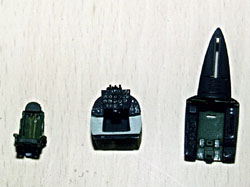 My plans came a cropper when I put the seat into the resin cockpit tub. When the instrument panel/gunsight section was added to the tub, it was clear that there was something wrong. The seat was about five scale feet from the instrument panel; since I have no records of orangutans being trained to fly combat missions, I assumed this was incorrect. A closer look at the tub revealed that most of the panel detail was spurious; this entire chunk of resin was unceremoniously dumped in the bin. My plans came a cropper when I put the seat into the resin cockpit tub. When the instrument panel/gunsight section was added to the tub, it was clear that there was something wrong. The seat was about five scale feet from the instrument panel; since I have no records of orangutans being trained to fly combat missions, I assumed this was incorrect. A closer look at the tub revealed that most of the panel detail was spurious; this entire chunk of resin was unceremoniously dumped in the bin.
I went back to the kit cockpit, painting it green and tire black, with drybrushed gray details and a few red and green spots picked out with a small brush. Bert Kinzey's “Detail and Scale” edition on the straight-wing Thunderjet was instrumental (no pun intended) in getting these consoles to look right. The seat and control column from the kit were left out until after the kit had been painted; a few styrene strip structural details were added to the fuselage sides to obscure the ejector pin marks on the side of the cockpit. These parts all integrated nicely with the resin/brass control panel section, and the cockpit was installed into one of the fuselage halves. Next came the splitter/nose gear section. The center of this is hollow, so I filled it with split shot to make sure the plane stayed on its landing gear once finished. The splitter was glued together, and the seam on the front was addressed, but a seam inside the nose wheel well was inaccessible for files and sandpaper. Instead, I carefully cut pieces of styrene to match the outline of the “roof” of the nose gear bay to hide the seam. I also removed the pitot from the front of the splitter, drilled a hole where it had been, and replaced it with a piece of metal tubing with a small bit of wire inside it. This well-matched pair of pieces was taken from an actuator set intended for RC cars. 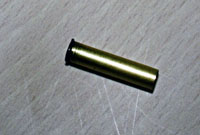 The tailpipe was provided in halves, but I had little desire to sand the seams inside a narrow tube, so I discarded these parts in favor of a length of brass tubing. The end of the kit pipe, with its nice engine section detail, was added to one end of the tubing; then the whole assembly was painted in a very dark shade of gray. The tailpipe was provided in halves, but I had little desire to sand the seams inside a narrow tube, so I discarded these parts in favor of a length of brass tubing. The end of the kit pipe, with its nice engine section detail, was added to one end of the tubing; then the whole assembly was painted in a very dark shade of gray.
Before I closed the fuselage, I added a section of brass from the AeroMaster kit to what would have been the speed brake bay. In looking around for a notable F-84 to build, I stumbled across the odd fact that 1951 was the one and only year for Thunderjet kills, and in 1951, the only Thunderjet models flying in combat were -E models. The -E varies from the kit-provided -G model in a few ways—the tailpipe was slightly longer, the speed brake was different, there were no side-mounted blow-in doors, and there was no integral refueling port. I decided to do an -E, and set about making the necessary modifications. Now, I would have started with the Academy F-84E/G, which provides the needed parts to build either version. 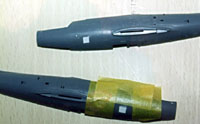 I started by filling the blow-in doors with styrene and sanding them flush against the fuselage. The refueling port was also filled in and sanded flush. I picked a speed brake from the AeroMaster kit that was appropriate, and planned to add it later. I started by filling the blow-in doors with styrene and sanding them flush against the fuselage. The refueling port was also filled in and sanded flush. I picked a speed brake from the AeroMaster kit that was appropriate, and planned to add it later.
The fuselage went together with no trouble whatsoever, but the nose ring went on and left a titanic step between it and the rest of the fuselage. Worse yet, the ring included the cutout and door for the extreme front end of the nose wheel well, bust these were out of place so badly that you could see all the way to the table through the front of the intake. Bits of styrene were added and sanded down to cure this most unsightly flaw. The wings fit together well, although I took extra care to sand the tip tanks to perfect roundness. The tip lights were added at this time, and it took some blending to get them to match the contours of the tank. The wings went into place with a little difficulty; Tamiya's engineering makes sure the dihedral is correct, but small gaps were left at the lower wing root, which were hard to address because of the integrally-molded wing pylons. The horizontal stabilizers went into place with no such problems; these fit precisely and required no filler. 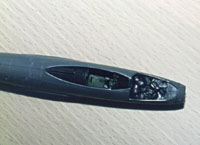 However, this point in construction indicated that, even with the weight in the splitter, the plane would be a tail-dragger. Not to worry—I had yet to add the gun bay door on the top of the nose! I wanted to close the door anyway, so more birdshot went into this compartment, then the door was cemented closed. As with the nose ring, the fit of this part was abominable and required a lot of filling and sanding. As I was whittling away in the nose of my fighter, I wondered why so many of my 1:48-building brethren sang Tamiya's praises so loudly when it came to fit while excoriating other companies' kits. Perhaps it just doesn't scale down well. However, this point in construction indicated that, even with the weight in the splitter, the plane would be a tail-dragger. Not to worry—I had yet to add the gun bay door on the top of the nose! I wanted to close the door anyway, so more birdshot went into this compartment, then the door was cemented closed. As with the nose ring, the fit of this part was abominable and required a lot of filling and sanding. As I was whittling away in the nose of my fighter, I wondered why so many of my 1:48-building brethren sang Tamiya's praises so loudly when it came to fit while excoriating other companies' kits. Perhaps it just doesn't scale down well.
Once the step was fixed on the machine gun bay, I went back and rescribed the gun door panel line. I added four more details to the gunsight area - a small map light, a small red placard, the gunsight selector lever and the gunsight glass, fabricated from the cellophane front of an old SuperScale decal envelope. Then I added and blended the windscreen, leaving a slight gap at the front where the gun compartment door closed. I masked the windscreen with Parafilm, and then touched up every panel line that had been obscured. Once this was done, I polished the model with Blue Magic auto polish; this prepared the surface for the natural metal finish and revealed flaws, which stuck out when the gleaming bare plastic was looked at under a strong light. The flaws were cleaned up, the model was polished again, and I was ready to paint. Now it came time for me to pick an aircraft. Like any true sufferer of AMS, this required me to purchase every decal sheet I could find for the F-84: three from AeroMaster, a couple from SuperScale, and one from Carpena. The plane I really wanted to build, the one used by astronaut Wally Schirra to score a kill over a MiG-15 in November 1951, was not available, and my efforts to find pictures of this aircraft 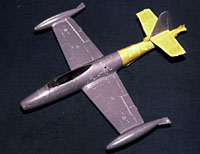 proved futile. My next best bet was Skeen's aircraft, because of the story of his kill and because of the airplane's name, “Benny-San.” Ben Pada is a constant inspiration with the number of excellent models he can build, so I opted to build his namesake, hoping some of his ability would rub off on me! proved futile. My next best bet was Skeen's aircraft, because of the story of his kill and because of the airplane's name, “Benny-San.” Ben Pada is a constant inspiration with the number of excellent models he can build, so I opted to build his namesake, hoping some of his ability would rub off on me! The markings of the 9th Fighter Bomber Squadron in Korea were simple enough—red stripes on a white tail. I started painting by masking off and painting the white tail. I masked the bare plastic so the natural metal paint would not be marred by the flat white; the fine grain of this paint could be enough to ruin the shine of the paint applied over it. The tail was masked off, and I then masked off the olive drab anti-glare panel that runs the length of the fuselage. Getting this aligned is critical; tape can be deceiving and I spent a lot of time making sure the lines of the panel were constant and symmetrical. Model Master olive drab was airbrushed over the fuselage and the tape was removed, revealing a neat green stripe down the Thunderjet's back. I waited a few days and masked the anti-glare panel in advance of applying the natural metal scheme. Before I picked up my airbrush, I spent some quality time with 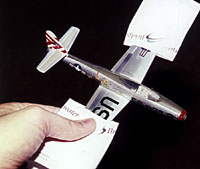 F-84 Thunderjet Units in Korea from Osprey's series of all-color books on Korean War aircraft to familiarize myself with the nuances of the various shades of metal panels on the F-84. I also dug out the old Lumonz Alclad Painting Guide, which provided a handy coded diagram of the F-84's exterior and assigned different values to the color of the metal in various locations over the entire airplane. F-84 Thunderjet Units in Korea from Osprey's series of all-color books on Korean War aircraft to familiarize myself with the nuances of the various shades of metal panels on the F-84. I also dug out the old Lumonz Alclad Painting Guide, which provided a handy coded diagram of the F-84's exterior and assigned different values to the color of the metal in various locations over the entire airplane. After meditating on the various shades on the real plane, I started with an overall coat of buffing aluminum, which was polished with a soft T-shirt. The model now looked like metal, all right; it looked just like a hood ornament! I used post-it notes, Parafilm and handheld index cards to mask off various panels, and added drops of yellow, purple and black to the aluminum paint to achieve various shades of metal. For the area below the cockpit, which had a darker and less reflective tone, I used a bit of steel mixed with titanium. The leading edge of the wings were a bit too yellow when I first painted the model; it looked as if they had been anodized! I masked again and sprayed with non-buffing aluminum, which restored the look to something a bit more acceptable. Various panels were then masked off and gently polished with SnJ powder. This made them look positively mirror-like, and I was glad I had been sparing with the effect! The tanks were also polished, since their round surfaces would really benefit from the extra shine. 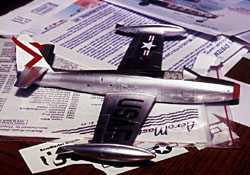 The canopy was masked with Bare Metal Foil and painted twice—first, with non-buffing aluminum on the metal sections, then white for the fiberglass reinforcing strips. Masking these sections was not a lot of fun, and the Cutting Edge “Black Magic” vinyl masks I hoped to use proved utterly useless. The masks don't allow for the rather sharp curvature of the 1/72 canopy and simply don't fit the locations for which they were intended. I was able to use the round mask for the canopy equipment access panel, but even this required considerable modification to be useable. Once this was dry, I used the AeroMaster Choice equipment shelf and some sheet styrene to finish off the canopy. The canopy was masked with Bare Metal Foil and painted twice—first, with non-buffing aluminum on the metal sections, then white for the fiberglass reinforcing strips. Masking these sections was not a lot of fun, and the Cutting Edge “Black Magic” vinyl masks I hoped to use proved utterly useless. The masks don't allow for the rather sharp curvature of the 1/72 canopy and simply don't fit the locations for which they were intended. I was able to use the round mask for the canopy equipment access panel, but even this required considerable modification to be useable. Once this was dry, I used the AeroMaster Choice equipment shelf and some sheet styrene to finish off the canopy.
Next came the most troubling part of the build: the decals. The Carpena sheet had the proper markings for “Benny-San,” but the Iron Knights logo of the 9th FBS and the other markings seemed a little soft in detail. Luckily, I had the AeroMaster sheet with another 9th FBS plane and I planned to use the generic squadron markings from this sheet. I quickly discovered I had decals at both ends of the quality scale. My Carpena test decal exploded on contact with water, while the Cartograf-printed AeroMaster decals refused to react to setting solutions! Some patience was required to get around these problems. 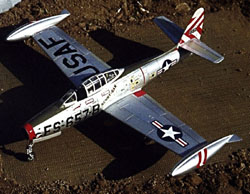 The Carpena tail markings didn't fit the tail of the Tamiya kit, and, as I expected, they shattered as I was trying to maneuver them into place. To get around this, I cut strips of red decal trim film and positioned them carefully on the white tail. I cut the silver block containing the serial number from the Carpena decals and applied it over the red trim film once the stripes were dry. The, a tiny “U.S. Air Force” legend was applied to above the serial. Each side of the tail had 12 different decals on it; this was a very arduous bit of decal work. Next time, I'll mask and paint. The Carpena tail markings didn't fit the tail of the Tamiya kit, and, as I expected, they shattered as I was trying to maneuver them into place. To get around this, I cut strips of red decal trim film and positioned them carefully on the white tail. I cut the silver block containing the serial number from the Carpena decals and applied it over the red trim film once the stripes were dry. The, a tiny “U.S. Air Force” legend was applied to above the serial. Each side of the tail had 12 different decals on it; this was a very arduous bit of decal work. Next time, I'll mask and paint.
The AeroMaster stars and bars and “USAF” legends on the wings refused to snuggle down, so they were stripped and replaced by decals from the AeroMaster Choice kit, which were printed by Microscale. All the trim film was cut from the decals; trim film has a nasty way of becoming very visible once applied to natural metal surfaces. The Microscale decals went on with no problems whatsoever. The critical “Benny-San” and other personal decals came off the sheet intact and were applied with no problems. However, the AeroMaster decal for the red ring around the nose only reached the edges of the anti-glare panel—in reality, the ring wrapped all the way around the nose! I cut out a bit more red decal from the same sheet and negotiated its way onto the model. 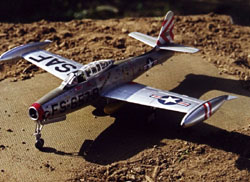 The Carpena buzz numbers exploded on contact with water; these were replaced with AeroMaster decals, placed one by one in sequence to the fuselage sides. The Carpena buzz numbers exploded on contact with water; these were replaced with AeroMaster decals, placed one by one in sequence to the fuselage sides.
Once the basic markings were applied, I needed to add the prominent and extensive data stenciling. I could find no sheet better than the one for the Academy F-84E/G; not only were these stencils correct (as opposed to the over-thick Tamiya decals, which outline the history of the F-84G, something of dubious use to crew members), but they were so thin they required no trimming. These were the best kit decals I have ever used, another recommendation for the Academy kit stemming from building the Tamiya kit! The wheel wells were painted yellow zinc chromate, and the landing gear struts were put into place. The fit of the nose gear was a little iffy, especially after the filling I had to do for the poor-fitting nose ring. Worse yet, the nose wheel was too wide for the two-part fork; in trying to get this to fit, I ended up shooting the tiny part into oblivion. After a moment of tortured soul-searching, I came up with a weird but effective solution. I chopped the remaining front of the fork off, then went and fetched my old Heller F-84 kit. The fork from that kit was cut off the nose strut, thinned 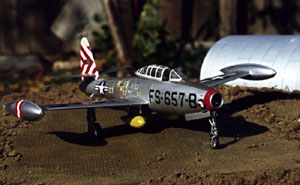 down, and glued to the nose wheel. Then, I attached the fork/wheel combo to the nose wheel strut. down, and glued to the nose wheel. Then, I attached the fork/wheel combo to the nose wheel strut. I added brake lines to the main gear struts, but since these were painted aluminum on the real plane, so the effect is minimal. The AeroMaster Choice resin wheels were used for the mains, and, after some clean up, the landing gear doors were added to the struts. With the model on its wheels, the last few bits were added. I used MV lenses to replicate the taxi lights mounted on the inner gear doors, and a photoetched rearview mirror went inside the windscreen above the gunsight. The fuel dump vents were added and painted silver. Finally, to arm my F-84, I opted not for 500-pound bombs but instead outfitted the plane with two napalm bombs, which started life as 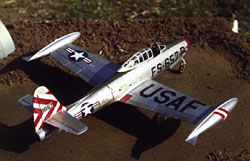 P-51D drop tanks in the Hasegawa kit. Painted yellow, these tanks were used as napalm containers, and they add a bit of extra color to the already colorful fighter. P-51D drop tanks in the Hasegawa kit. Painted yellow, these tanks were used as napalm containers, and they add a bit of extra color to the already colorful fighter. Conclusion There you have it—Tamiya's F-84, AMS-style! This model could surely have been built faster without some of the modifications, but I like the way my Thunderjet came out, and that's what really matters. | 


 




    |